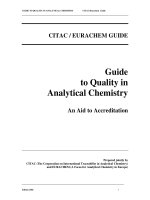Analytical chemistry mindmap
Bạn đang xem bản rút gọn của tài liệu. Xem và tải ngay bản đầy đủ của tài liệu tại đây (171.01 KB, 1 trang )
SI Units
Solution
Solute
Solvent
Mole
Atomic mass
Formula mass
Molecular mass
Molarity(mol/V)
Molality(mol/m solvent)
Chemical Concentrations
Chemical Measurements
Formal concentration
Strong electrolyte
Weak electrolyte
Electrolyte
Weight percent
Volume percent
Percent concentration
Distillation
Preparing Solutions
Deionization
Preparing solution by dillution
Mconc.Vconc = Mdil.Vdil
Gravimetric Analysis
Volumetric Analysis
Stoichiometry Calculations for Gravimetric Analysis
9.25 x 10^4 - 3 significant figures
9.250 x 10^4 - 4 significant figures
9.250 0 x10^4 - 5 significant figures
0.000 925 - 3 significant figures
Significant Figures
Express all numbers with the same exponent.
• Align all numbers with respect to the decimal point.
• Round the answer according to the number with the fewest decimal
places.
exceed or be less than the number of
significant figures in the original data.
Addition and Subtraction
Significant Figures in Arithmetic
Multiplication and Division
the fewest significant figures
Number of digits in mantissa of log x = number of significant figures in x
Logarithms and Antilogarithms
arises from a flaw in equipment or
experiment design
Systematic
Experimental Errors
Number of digits in antilog x (=10x) = number of significant figures in
mantissa of x
arises from uncontrolled
variables in measurement
Random
Types of Error
due to accidental but significant departures from
procedure
Gross (blunders)
Precision and Accuracy
Absolute and Relative Uncertainty
Addition and subtraction:
Propagation of Uncertainty from Random Error
Multiplication and division
Mixed operations
Propagation of Uncertainty from Systematic Error
Mean(average)
Mean Value and Standard Deviation
measures how closely data are
clustered about the mean
Standard deviation
Gaussian Distribution
Degrees of freedom
Variance
Relative standard deviation (coefficient of variation):
Other Statistical Parameters
Null hypothesis: states that two sets of data are drawn from populations
with the same properties
Comparison of Standard Deviations with the F Test
Ftest > Fcalculated --> Reject the null hypothesis
Fcalculated = s1^2 / s2^2 ( s1 >= s2)
Confidence Intervals
Student’s t: used to compare results from different experiments
The t test determines if there is a statistical difference between
x1 and x2 ( x : average)
ttest > tcalculated --> reject the null hypothesis
Comparing Measured Result with “K nown” Value
Comparing Replicate Measurements When Standard Deviations Are Not Significantl
y Different (2a)
Comparison of Means with Student's t
Three cases
Comparing Replicate Measurements When
Standard Deviations Are Significantly Different(2b)
Statistics
Paired t Test for Comparing Individual Differences
One-Tailed and Two-Tailed
Significance Tests
t Tests with a Spreadsheet
a statistical test to decide whether to discard a datum that
appears discrepant (an “outlier”).
Grubbs Test for an Outlier
Gtest > Gcalculated --> Reject the null hypothesis
• Prepare a calibration curve from known standards.
• Work in a region where the calibration curve is linear (usually)
The Method of Least Squares
Calibration Curves
used to draw the “best” straight line through
experimental data points that contain some scatter
shows the response of an
analytical method to known quantities of analyte.
Standard solutions
Blank solutions
A Spreadsheet for Least Squares
is what we do to get the right answer.
Use objectives
Raw data
Treated data
Results
Type of Blanks
Method blank
Reagent blank
Field blank
Basics of Quality Assurance
Matrix
Spike recovery
Spike(or fortification)
the process of proving that an analytical method is
acceptable for intended purpose
extent to which an analytical method can distinguish analyte
from everything else in the sample
Selectivity
Linearity
measures how well a calibration curve follows straight line
emphasize the difference between calibration data and
the least-squares line
Residual Plots
Method Validation
Instrument precision
Intra-assay precision
Intermediate precision
Interlaboratory precision
Type of precision
Quality Assurance
Linear range
Dynamic range
Range and Robustness
Robustness : ability of an analytical method to be unaffected by small,
deliberate changes in operating parameters
known quantities of the analyte added to the
unknown
change in analytical sensitivity caused by something in
the sample other than analyte
Mattrix effect
Standard Addition
Graphical Procedure for Standard Addition to
Single Solution
Graphical Procedure for Multiple Solutions with
Constant Volume
Standard addition
known amount of a compound—same substance as
analyte—added to the unknown
Internal standards
known amount of a compound—different from
analyte—added to the unknown
Internal Standards
solutions with known concentrations of analyte used
to prepare a calibration curve
External standards
Multipoint Calibration Curve for Internal Standard
Equilibrium constant, K
Reaction is favored if K > 1
Equilibrium constants are dimensionless
Each quantity in the ratio is given as concentration at standard state.
The Equilibrium Constant
•If the direction of a reaction is reversed, the new value of K is simply
the reciprocal of the original value of K.
• If two reactions are added, the new K is the product of the two
individual equilibrium constants.
• If n reactions are added, the overall equilibrium constant is the
product of n individual equilibrium constants.
Manipulating Equilibrium Constants
•Δ H positive, heat is absorbed and the reaction is endothermic.
•Δ H negative, heat is released and the reaction is exothermic.
The heat absorbed or released
Enthalpy
• If Δ S is positive, the products have greater entropy than the reactants.
• If Δ S is negative, the products have lower entropy than the reactants.
Δ S = qrev/T
the dispersal of energy into
molecular motions
Entropy
Gibbs free energy (Δ G) is the arbiter
between opposing tendencies of Δ H and Δ S. At
constant temperature (T):
Equilibrium and Thermodynamics
Free energy
A reaction is favored if Δ G is negative.
Le Châ telier’s Principle
make thermodynamic predictions, not kinetic
predictions.
Equilibrium Problems
equilibrium constant for the reaction in which a solid
salt dissolves to give its constituent ions in solution
Saturated solution
Use the solubility product to find concentration of one ion when
concentration of the other is known or fixed by some means.
Solubility Product
Chemical Equilibrium
Disproportionation
the process in which an element in an intermediate oxidation state, such as Hg(I), gi
ves products in both higher and lower oxidation states
Common Ion Effect
the application of Le Châ telier’s principle.
Complex Formation
Anions (X ) that precipitate metals (M+) are often observed to form complex ions
refers to chemistry involving transfer of an H+ from one molecule to another
acid is a proton donor.
base is a proton acceptor
salt contains cations and anions.
Strong electrolytes dissociate nearly completely into ions in dilute aqueous solutions.
Brø nsted-Lowry Acids and Bases
Protic Acids and Bases
Conjugate Acids and Bases
The Nature of H+ and OH
Autoprotolysis (self-ionization)
Water undergoes autoprotolysis in which it acts as both acid and base.
pH < 7 --> Acidic solution
pH > 7 --> Basic solution
pH = 7 --> Neutral
pH Scale
• However, these are
not the limits of pH
• Very high
concentrations of
acid can reach pH =
1
pH
Learnt Chapters
• Strong acids/bases react nearly “c ompletely” to produce H+
/OH
.
• Weak acids/bases react only “partially” to produce H+
/OH
.
The acid dissociation constant (Ka) is the equilibrium constant for a weak acid reacti
ng with water. Ka is “s mall” for weak acids.
Weak Acids and Bases
The base hydrolysis constant (Kb) is the equilibrium constant for a weak
base reacting with water. Kb is “s mall” for weak acids.
Strengths of Acids and Bases
• Most carboxylic acids are weak acids.
• Most carboxylate anions are weak bases.
Common Classes of Weak Acids and Bases
Polyprotic Acids and Bases (Oxalic Acid)
Carbonic Acid
is formed by the reaction of carbon dioxide with water.
Polyprotic Acid and Conjugate Base
Volumetric analysis
Titration
quantity of added titrant is exact amount necessary for
stoichiometric reaction with the analyte
Equivalence point
the ideal (theoretical) result based on stoichiometry
actual measurement, marked by a sudden change in physical property
of the solution
End point
Titrations
Titration Error
Titration error
Blank titration
Primary Standards
Standardization
• Prepare a titrant with approximately the desired concentration and use it to
titrate a primary standard
• Method can be used to determine the concentration of the titrant
• Validity of analytical result ultimately depends on knowing the concentration
of the primary standard
Direct titration
Back titration
Gravimetric titration
Types of Titrations
The key step in any titration calculation is to relate
moles of titrant to moles of analyte.
Titration Calculations
Standardization of Titrant Followed by
Analysis of Unknown
Titration of a Mixture
show how concentration of reactant varies as titrant is added
Concentration varies over orders of magnitude so use p function.
pX = log10[X]
Titration
Equivalence Point of Precipitation Titration
Before the Equivalence Point
Precipitation Titration Curves
At the Equivalence Point
After the Equivalence Point
Shape of the Titration Curve
Ksp Affects Titration Equivalence Point
Calculating Concentrations During a
Precipitation Titration
Titration of a Mixture
If a mixture of two ions is titrated, the less soluble precipitate forms first.
Calculating Titration Curves with a Spreadsheet
Volhard Titration
End-Point Detection
Fajans Titration
commonly used to measure [Cl ] (can be adapted for
other anions)
can be applied to many systems
Adsorption Indicators
Electrochemistry
involves transfer of electrons from one reagent to another
reagent.
Redox Reactions
• The oxidizing agent, also called the oxidant, takes electrons from the
reducing agent. In this process, the reducing agent is oxidized.
• The reducing agent, also called the reductant, gives electrons to the
oxidizing agent. In this process, the oxidizing agent is reduced.
Redox reactions involve electron transfer
The electrochemical cell isolates the electrons
electrochemical cell
can be readily connected to instruments that measure the electric current and
potential associated with the redox reaction.
is a measurable property of the electrons
that are transferred in a redox reaction.
Electric Charge
Calculating the total charge of an ion
is the quantity of charge flowing each second
through a circuit.
Electric Current
The unit of current is the ampere, abbreviated A.
Basic Concepts
Any electric charge creates an electric potential.
• Electric potentials of opposite sign are attractive.
• Positive and negative charges attract each other.
• Electric potentials of the same sign are repulsive.
• Positive charges repel other positive charges; negative charges repel other negativ
e
charges.
Voltage, Work, and Free Energy
• Potential difference is measured in units of volts (V).
Relation between work, voltage, and charge
W = E.q
Sign conventions for heat and work
Calculating Δ G: Gibbs Free Energy of Reaction
states that current, I, is directly proportional to the potential
difference, E, across a circuit and inversely proportional to the
resistance, R, of the circuit.
Ohm’s Law
Power
A battery gives off its energy as either heat or work
is the work done per unit time.
The SI unit of power is the watt (W)
uses a spontaneous redox
reaction to generate electricity
The potentiometer in the circuit measures
the difference in electric potential (voltage)
between the two metal electrodes.
A Cell in Action
Emeasured = E+ - EThe net reaction is composed of a reduction and an
oxidation, each of which is called a half-reaction.
Galvanic Cells
The two half-reactions are written with equal
numbers of electrons before adding to obtain the
net reaction.
Half-Reactions and Net Reactions
A single-vessel Galvanic cell does not always
work
is a U-shaped tube filled with a gel containing
KNO3 or other electrolyte not involved in the reaction.
Divided cell with a salt bridge
The design of a galvanic cell can be
summarized using line notation.
Line Notation for Galvanic cells
Potentiometer
The instrument that is used to measure the voltage of a
galvanic cell
Fundamentals of Electrochemistry
Practical application of galvanic cells: pH meters
When a pH probe is dipped into a solution to
measure pH, a galvanic cell is created.
• The pH probe constitutes one half-cell with a saltbridge.
• The solution whose pH is measured constitutes
the second half-cell.
• The pH meter is the potentiometer (voltmeter).
• The center wire of the BNC socket is the positive
input.
• The outer connection of the BNC socket is the
negative input
Measured cell potential
Standard Potentials
Standard conditions for galvanic cells
When all components of both half-cells are present
at standard concentrations, pressures, and
temperatures, then the measured cell potential
Standard cell potential
o E+ is the standard reduction potential of the electrode
attached to the positive terminal.
o E • is the standard reduction potential of the electrode
attached to the negative terminal.
Predicting standard cell potential
The standard hydrogen electrode (S.H.E.) is a half-reaction whose standard reductio
n potential is defined to be 0 at 25° C. The S.H.E. is used as a reference half-reaction
to measure other standard half-reaction potentials
How are standard half-reaction potentials
measured?
• The cell voltage for standard cells can be readily predicted using the tabulated halfreaction standard reduction potentials.
How is a nonstandard potential calculated?
Nernst Equation
The Nernst Equation
is used to calculate the reduction potential for each half-cell (E+ or E
under nonstandard conditions.
)
The simplified Nernst equation at 298.15 K
The net reaction Nernst equation
E° and the Equilibrium Constant
E° and the Equilibrium Constant
• Galvanic cells produce electricity when they are not at equilibrium.
• The voltage of a good battery can be predicted by the Nernst equation.
• When a battery has died, the chemicals inside have reached equilibrium (Q = K)
and the battery voltage has dropped to zero (E = 0 V)
Finding K for Net Reactions That Are not Redox
Reactions
Biochemists Use E° ′
Redox Titration Curve: Before Titrant Is Added
The initial potential of
the analyte solution
(before any titrant is
added) is highly
sensitive to impurities
and cannot ordinarily
be accurately
calculated.
Redox Titration Curve: Before the Equivalence Point
Redox Titration Curve: Half Equivalence Point
The Shape of a Redox Titration Curve
Redox Titration Curve: At the Equivalence Point
Redox Titration Curve: After the Equivalence Point
Redox Titration Curve: Twice the Equivalence Point
Titration Curve Symmetry Near Equivalence
Point
is a compound that changes colors when going from its oxidized
to reduced state.
Redox Indicators
Finding the End Point
Gran Plot
uses data from well before Ve
to locate Ve
Starch-Iodine Complex
Redox Titration
Oxidation state adjustment is especially useful for analytes that contain an element i
n multiple oxidation states.
Preadjustment of Analyte Oxidation State
must be quantitative.
Excess preadjustment reagent must be eliminated so that it does not interfere in the
subsequent titration.
Preoxidation
Prereduction
An important prereduction technique uses a packed column with a solid
reducing agent.
Adjustment of the Analyte Oxidation State
Prereduction Columns
Jones reductor: a column packed with zinc coated with a zinc amalgam
• Zinc is a powerful reducing agent.
• Not very selective.
• Mercury is a toxic waste hazard, so its use should be minimized.
Walden reductor: a column filled with solid silver and 1 M HCl
• It is more selective than the Jones reductor.
Finding Environmentally Friendly Replacements
for Toxic Reductants
Classical Nitrate Assay
Environmentally Friendly Nitrate Assay









